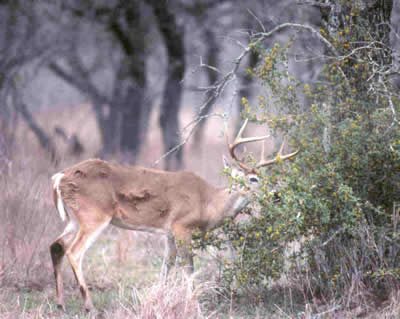South Texas Plains Habitat Population Management/Hunting (Gun)

Too many deer can overbrowse habitats. Photo by Joe Herrera.
Mother Nature provides a surplus of animals to compensate for death losses in a species. In populations where management does not occur, animal numbers will soon build to levels exceeding range carrying capacity resulting in habitat abuse, starvation, and death. A regulated harvest helps assure that there is plenty of food for the number of animals present on the range. Balancing deer numbers with the amount of forage available insures maximum body and antler growth in order for more animals to reach their genetic potential.
Since we know White-tailed deer prefer forbs and woody browse, biologists use these plants to judge the quality of habitats and to assess range overuse should it be occurring. Forbs are seasonal and fluctuate with rainfall patterns and timing of grazing. Woody browse plants, on the other hand, are deeply-rooted and offer more stability. However, not all browse plants are preferred by deer. Woody plants such as whitebrush, twisted acacia, mesquite, coyotillo, and allthorn goatbush offer limited wildlife food value. Other plants such as Texas kidneywood, spiny hackberry (granjeno), Texas porliera (guayacan), saffron-plum bumelia (coma), prickly pear cactus, sugar hackberry, cedar elm, four-wing saltbush, and southwest bernardia are considered preferred deer foods. In assessing habitats, preferred plants should not display removal of over 50% of their current year's growth. If this is the case or if poor quality plants show heavy use by deer (hedging), range overpopulation is probably occurring! When using hunting as a management tool, biologists also consider the sex ratio of bucks to does, the age of the deer, and the genetics of the herd.

Hunters help to control deer populations. Photo by Alan Cain.
The management techniques discussed in the habitat management pages -axe, cow, plow, and fire-do little good when deer numbers exceed the available food supply. For rangelands to respond to these various management practices, deer must be harvested and maintained at or below the carrying capacity of the land. A balanced harvest also emphasizes the harvest of antlerless (female) deer. Natural predators as well as hunters play a role in keep deer populations at or below carrying capacity of the land. For more information on a regulated harvest for South Texas, see Deer Management in the South Texas Plains. For technical assistance regarding deer management, contact your local TPWD Wildlife Biologist.

Natural predators such as coyotes and mountain lions also control deer populations. Photo by Robert Perez.